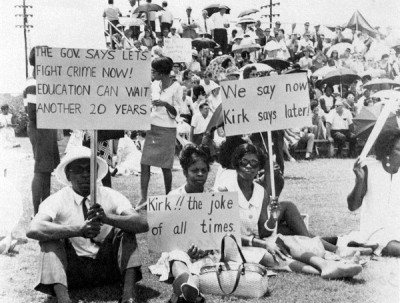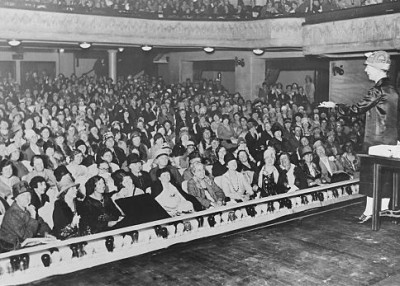Ed in the Election: Ryan leaves out education in Romney’s economic plan
Republican vice presidential nominee Paul Ryan neglected to mention education when summarizing Mitt Romney’s five-point plan to improve the economy in Thursday night’s debate with Vice President Joe Biden. Overall, the issue was mentioned only a handful of times in a freewheeling discussion that covered domestic and foreign issues.
While summarizing his running mate’s plan, Ryan said the second priority is to “help people who are hurting get the skills they need to get the jobs they want.” He was likely referencing the broader heading of that section in Romney’s paper: “Skills to succeed.” But Romney frequently mentions the specific goal of improving schools when describing this portion of the plan– and did so in his own debate last week.
There were no questions asked about education and neither candidate tried to steer the conversation toward it. When education did come up, it was only in passing. Ryan explained how Social Security survivor benefits helped him go to college and shared an anecdote about Romney paying the college bills for a struggling family.
While debating taxes, Biden emphasized his ticket’s plan to keep tax breaks in place for parents sending their children to college. “Why does my friend want to cut out the tuition tax credit for them?” Biden asked of Ryan.
In the final moments of the night, Biden mentioned education when slamming Ryan’s budget proposal, saying it would cut federal funding for education by $450 billion. That figure is extrapolated from Ryan’s plan to cut discretionary spending by 20 percent overall. The Romney-Ryan campaign has not specified what the exact decrease to the education budget would be, but during the presidential debate last week, Romney said–for the first time–that he would not decrease education funding at all.
Are new online standardized tests revolutionary? Decide for yourself.
New high-tech standardized tests are coming soon to schools across the country, but will these new tests really revolutionize how we measure whether children are learning? The designers of the new tests, which a majority of states plan to adopt in two years, are allowing a sneak peek at sample questions, so you can decide for yourself.
Two competing state coalitions have taken on the job of designing the new tests, the Partnership for Assessment of Readiness for College and Careers (PARCC) and the Smarter Balanced Assessment Consortium, and both have posted examples of what’s coming on their websites.
- Sample English/Language Arts question from Smarter Balanced Assessment Consortium
- Sample Math question from Smarter Balanced Assessment Consortium
- Sample question from third grade assessment from PARCC
- Sample math question from high school assessment from PARCC
In some questions, which the test designers have called “computer enhanced,” students will be asked to drag words or numbers across the screen, or to highlight phrases or sentences in a reading passage. In one example provided by Smarter Balanced to reporters during a conference call Monday, high school students can click on the screen to transfer water from a cube to a cylinder, which helps them solve a math problem about radius.

Fifth graders at Townsend Elementary in the Appoquinimink district waiting to begin the state standardized reading test. (Photo by Sarah Garland)
There will also be problems that require research and writing. Smarter Balanced officials gave an example of a multi-part question in which high school students are asked to imagine they are the chief of staff for a congresswoman. Before they start working on the test, their teacher is supposed to lead a classroom activity about nuclear power. The students are then asked to come up with a list of pros and cons about nuclear power. Finally, they must write up a presentation for the congresswoman to give at a press conference later that day.
“I can tell you, that’s real world,” said Barbara Kapinus, the director of English language arts and literacy for Smarter Balanced. “I’ve been in that situation.”
Many questions will continue to be multiple-choice, however. States have favored multiple-choice tests because they are cheaper to design and score, and since answer sheets can be run through a computer. Questions like the one about nuclear power are more expensive, because they will likely require a trained evaluator to score them.
One of the biggest concerns about the new tests has been how to finance them. The two coalitions designing the tests won grants from the federal government to pay for the beginning of the process, but this funding won’t cover ongoing expenses related to the tests, like paying people to score answer sheets and the cost of new computers and expanded bandwidth.
In the conference call with reporters, the director of Smarter Balanced, Joe Willhoft, said states that have signed on for the tests have agreed to pay annual administrative fees associated with the tests. “The lion’s share of those costs is bundled up in the human scoring,” he said.
Ed in the election: Obama and Romney spar over education spending in first presidential debate
In the first presidential debate Wednesday night, President Obama and Republican presidential contender Mitt Romney immediately dove into an often neglected topic on the campaign trail: education.
The issue came up early and often, starting when both candidates mentioned education in their opening statements. Obama called for increased investment in public schools; Romney said the U.S. needs to have “the best schools in the world.”
Obama repeatedly hammered on the idea that he has supported education spending, while charging that Romney would reduce resources for schools in a quest to reduce the deficit. To emphasize his point, Obama told the story of a Las Vegas teacher who had 42 students in her classroom for the first two weeks of school and 10-year-old textbooks to teach them with.
“That is not a recipe for growth,” Obama said. “Budgets reflect choices. And if we’re asking for no revenue, that means we’ve got to get rid of a whole bunch of stuff. And the magnitude of the tax cuts that you’re talking about, Governor, would end up resulting in severe hardship for people, but more importantly would not help us grow.”
Romney rejected Obama’s claim that he would cut education spending by 20 percent if elected – a figure extrapolated from his running mate Paul Ryan’s proposed budget – and decrease aid for college students. “I don’t have any plan to cut education funding and grants that go to people going to college,” Romney said. “I’m not planning on making changes there.”
In the past, Romney has discussed making the U.S. Department of Education a “heck of a lot smaller,” although he has not specified what programs would be eliminated. During the debate, Romney called for getting rid of inefficient federal programs in all areas.
“I will eliminate all programs by this test, if they don’t pass it: Is the program so critical it’s worth borrowing money from China to pay for it?” he said. One item on the chopping block would be federal subsidies to PBS, even though Romney said he loves Big Bird and likes the debate’s moderator and PBS NewsHour host Jim Lehrer.
Obama countered that he has ended 18 educational programs that were “well-intentioned [but] weren’t helping kids learn.”
The impact of teacher layoffs also came up, as Obama suggested that Romney would preside over more reductions in the teaching force. Obama’s stimulus package saved or created 250,000 teaching jobs, but there still have been hundreds of thousands of teachers laid off during his administration. Obama proposed an additional $30 billion to save nearly 400,000 teacher jobs in 2011, but the bill never passed. “Romney doesn’t think we need more teachers. I do,” Obama said. “That is an investment where the federal government can help. It can’t do it all, but it can make a difference.”
Romney disagreed with that characterization. “I love great schools,” he said, noting that when he was governor of Massachusetts the state had the highest-ranked school system in the country. “And the key to great schools, great teachers. So I reject the idea that I don’t believe in great teachers or more teachers. Every school district, every state, should make that decision on their own.”
One of the few ideas the candidates said they agreed on over the course of the night was Race to the Top, Obama’s signature education program that prompted 46 states to adopt education reforms in a competition for federal funds. The Democrats largely ignored the initiative at the Democratic National Convention, but Obama mentioned it three times during the debate.
Romney said he agreed with “some” of the ideas in Race to the Top. But he took the opportunity to promote his own school-choice platform, which would allow federal funds to follow special-needs and low-income students to the school of their choice, whether public or private. There is no guarantee, however, that a school would have to accept them.
Obama tried to paint Romney as out of touch when it came to education, though – particularly higher education.
“Governor Romney, I genuinely believe, cares about education,” Obama said. “But when he tells a student that, you know, ‘you should borrow money from your parents to go to college,’ you know, that indicates the degree to which, you know, there may not be as much of a focus on the fact that folks like myself, folks like Michelle … just don’t have that option.”
Education Nation: Revived support for grammar instruction
With American schools focused on raising reading and math scores to meet accountability requirements, writing often takes a backseat. The class of 2012 posted the lowest average writing score on the SAT this year since writing became part of the exam in 2006.
But with 45 states adopting Common Core standards that include writing and specifically grammar, some educators are examining new ways to bring grammar back into the classroom.
“I think increasingly there’s an understanding that while we don’t ever want to go back to the drill and kill approach, from research and educators, we know that [explicit grammar instruction] is a critical component in education,” said Roberta Stathis, executive director of The Teacher Writing Center, which runs the Grammar Gallery, an online resource for writing and reading instruction.
Day three of NBC’s Education Nation summit featured the winner of the $75,000 Citi Innovation Challenge, a website called NoRedInk! that helps students improve grammar and writing skills. The website incorporates popular culture into student lessons and allows teachers to track progress on individual writing concepts, with lessons aligned to the Common Core standards.
Currently, emphasis on grammar in curriculum varies from state to state. The Teacher Writing Center has seen an increase in districts using its online writing program, with about 50 currently participating. But Patrice Gotsch, associate director at the Center, says there are some teachers and administrators who don’t embrace explicit grammar instruction.
While grammar was one of the most-emphasized subjects during the 1950s, schools have shifted away from it since then, according to one study. “There’s plenty of research that traditional grammar instruction and diagramming sentences does not work,” said Sandra Wilde, a professor at Hunter College in New York City.
When the Common Core standards are rolled out in 45 states in 2014, teachers will be expected to explicitly teach concepts like participles and infinitives, and students will be expected to explain usage of such terms.
Wilde says she expects that the revival of grammar will prompt companies to develop new products and textbooks. She added that developers should ensure that online sites aren’t replicating the old grammar workbooks in a high-tech package. “To be good,” she said, “the developers would be well-served by really working with some literacy people who are up to date in the field and have some innovative ways of thinking about it.”
Ed in the election: Romney says he won’t fund Common Core adoption, takes shots at unions
Mitt Romney said Tuesday that the federal government would not aid the 45 states who adopted the Common Core State Standards if he is elected.
Visit NBCNews.com for breaking news, world news, and news about the economy
“I don’t happen to agree that every time there’s a good idea … the federal government should finance the implementation,” said Romney, who has opposed a set of new national standards which the Obama administration has supported. “I’m not willing to add more spending to get people happy with me.”
Speaking at NBC’s Education Nation, the Republican presidential nominee fielded questions directly from audience members about testing, local control and unions.
He told one audience member that he “didn’t believe” a poll that found parents in New York City supported the teachers union more than they did Mayor Michael Bloomberg. “I know something about polls, and you can ask questions and get any answer you want,” he said.
Romney also repeated a charge he often makes about teachers unions: that they care about their members’ interests more than children. “The teachers union has every right to represent their members in the way they think is best,” he said. “But we have a right to say, ‘No, this is what we want to do.’”
Romney said he respected teachers’ right to strike, recently exercised in Chicago; his bigger problem was with the fact that the unions donate so heavily to political campaigns, mostly to Democratic candidates. It creates a “conflict of interest,” he said.
Visit NBCNews.com for breaking news, world news, and news about the economy
President Obama was invited to attend the event but declined, instead giving a speech at the United Nations on Tuesday morning. In a prerecorded interview, Obama, who didn’t comment at the time, weighed in on the Chicago strike, saying he could understand both sides.
“It was very important for Mayor [Rahm] Emanuel to say let’s step up our game,” he said of his former chief of staff. “It was important for the teachers union to say let’s not just blame the teachers.”
Both candidates, however, spoke highly of teachers and the teaching profession in general.
“I really get frustrated when I hear teacher bashing as evidence of reform,” Obama said. “They work so hard. They’re putting money out of their pockets into the classroom every single day. They’re not doing it for the pay.”
Even so, Obama expressed his continued support for merit pay. “I think that pay for performance makes sense,” he said. Romney agreed that the best teachers should be more highly compensated.
Research has shown that merit pay does not have an impact on student achievement. And yet Romney and Obama also spoke of letting research guide school reforms.
“When we have good data that shows how do you improve schools, it shouldn’t just sit in a drawer,” Obama said. “We’re going to tell you what we think works.” Romney cited research showing that class size and per-pupil spending do not have a large impact on student achievement.
Romney also focused on the importance of parent involvement, frequently mentioning that he attempted to make parenting classes mandatory when he was governor of Massachusetts.
When it came to specific early education programs, though, he praised a few privately-run groups, like the Harlem Children Zone, and touched briefly on federal ones, including Head Start, which provides early childhood care for low-income families.
The Obama campaign has charged that a Romney administration would decimate the Head Start budget.
“We can evaluate where those have been effective and less effective,” Romney said of Head Start and other public programs.
Education Nation: Why educators aren’t sold on video games
Video games are increasingly popular learning tools in classrooms, but not all teachers are sold on the benefits.
Day two of NBC’s Education Nation summit highlighted the potential for video games to tailor material to a student’s individual level and allow teachers to track student progress. But while games can provide valuable information about how students learn, there is still little evidence that video games positively impact student achievement. And many teachers are skeptical about incorporating games in the classroom, even if it means students would be more invested in lessons.
During a Monday panel on gaming in the classroom, educators brought up some of their main concerns with the emerging technology. Todd Beard, a K-12 technology teacher in Flint, Mich., said his students have trouble transferring skills they learn playing educational games in class to paper-based tests. While his students may appear to master skills during a video game, they forget it when they’re taking an assessment later. Beard tells his students, “It’s the same thing, you just did that,’” he said. He believes his students aren’t as invested in tests because they aren’t as fun as the games. “I feel like they’re learning [skills], but I have to prove that on an assessment,” Beard added.
Children ages 8 to 18 spend an average of 7.5 hours a day using entertainment media, so some teachers say parents don’t want their kids spending more time playing video games at school. And funding can be an issue for some schools. “We pay for the [gaming] sites,” said Lyssa Sahadevan, a first-grade teacher in Marietta, Ga., speaking to The Hechinger Report after the panel. “So that’s a challenge.”
While Sahadevan says she has seen her first-graders transfer their skills from games to tests, she has struggled to find games that assess students as they play, so kids may spend time on a level that is too high or too low for them. Several of Sahadevan’s colleagues have embraced technology and encourage students to bring their own devices to school to engage in online learning. But in large classes with multiple students using devices, Sahadevan says it can be hard to monitor everyone.
Some educators worry that teachers haven’t been sufficiently trained to integrate video games into schools. “I’d love you to talk about the kinds of professional development that teachers are going to need,” said Anne Bryant, executive director of the National School Boards Association during the panel. “Where is it going to happen and how is it going to happen?” Her comment echoed the findings of a recent LEAD Commission poll, which reported that many teachers aren’t prepared to use technology effectively.
And while video games may be the future of digital learning, teacher Sahadevan says there are still basic issues that need to be fixed in education before more teachers will utilize technology. “We can’t get books in classrooms,” Sahadevan said. “Unless they’re going to give all these programs for free, its like dangling candy in front of a kid. We want it, but we can’t get to it, and that’s a problem.”
Education Nation: Teachers wary of new evaluations in aftermath of Chicago strike
NBC’s third annual Education Nation summit kicked off Sunday with a focus on solutions: ideas with a track record of success and potential for replication. But for teachers attending the event, a central concern continues to be new evaluations, which helped set off a teacher strike in Chicago this September.
Thirty-two states have made changes to teacher evaluation policies in recent years, according to a 2011 report by the National Council on Teacher Quality, and 23 now require that data about student learning be included in teacher ratings.
In a poll during a teacher town hall hosted by Education Nation on Sunday, 72 percent of teachers in attendance said they believe less than a third of their rating should depend on student test scores. Many said their students face barriers that affect their scores, which can lead to unfair assessments of their teaching. They expressed frustration about a lack of resources, the prevalence of poverty among their students, and a belief that the public doesn’t really understand what they’re up against every day.
Tension rose quickly after a charter-school teacher said that while previously working at a district-run school, the union told her not to work past a certain time. “I didn’t care, I just stayed,” she said. District teachers in the forum responded that they too work long hours. AFT president Randi Weingarten wrote on Twitter that there are “no prohibitions” in contracts regarding hours spent at school.
NBC education correspondent Rehema Ellis said her main takeaway from covering the Chicago teachers’ strike was that “teachers suffer from a perception problem,” explaining that most people do not understand why teachers are upset about some issues, like lack of air conditioning in schools, because many of the issues are not framed correctly and may seem trivial to the public.
Despite the divisions over evaluations, however, teachers were united on other ideas about how to improve classroom teaching. “Teachers need to know kids first, content comes second,” said one teacher. “What our children most need is the belief in their ability to succeed,” added another. “They absolutely must have that message.”
Ed in the election: Romney breaks from Ryan budget on Pell grants
Mitt Romney said he doesn’t agree with his running mate Paul Ryan when it comes to Pell grant funding Wednesday at a “Meet the Candidate” event geared toward Latino voters.
Ryan’s budget would reduce funding for Pell grants, which are given to low-income students to attend college, increase eligibility requirements and freeze the maximum grant at $5,550, according to the Center on Budget and Policy Priorities. President Obama supports raising the maximum to $5,635 – about a 1.5 percent increase.
Speaking at the event, hosted by Spanish-language TV station Univision and held at the University of Miami, Romney went against his vice presidential pick. “I care about your education and helping people of modest means get a good education and we’ll continue a Pell grant program,” he said. “The Republican budget called for Pell grants being capped out at their current level. My inclination would be to have them go with the rate of inflation.”
The rate of inflation was 3 percent in 2011. Romney added that keeping the grants growing at the rate of inflation would help keep college costs down overall. He said that the “best thing” he could do for the University of Miami students, though, was to make sure they had jobs waiting for them when they graduated.
“The best thing I can do is not to [say,] ‘Hey, I’ll loan you more money. Here let’s loan you,’” he said. “I don’t want to overwhelm you with debts. I want to make sure you can pay back the debts you’ve already got and that will happen with good jobs.”
Romney also spoke of the need for merit pay to attract high-quality teachers into the profession and mentioned his school choice plan, in which low-income and special needs students would be able to use federal dollars to attend any school of their choosing – if the school wants to enroll them, that is.
“We have to change from a union-dominated setting to one where the very best and brightest are highly-compensated,” he said. “They become mentor teachers, we don’t have them go into administration, but they find teaching a wonderful profession for their entire careers.”
The rise of teacher unions: A look at union impact over the years
The Chicago teachers strike, which ended Tuesday after more than a week of protests and negotiations, has emphasized the power that teachers’ unions can have. Since the earliest days of unions, teachers have been fighting over some of the same issues in contention in Chicago: salaries, conditions at schools and tenure. A look at the history of unions and strikes shows how unions gained power, and their varying levels of success in past collective bargaining attempts across the country.
1857: The National Education Association (NEA) is founded in Philadelphia by 43 educators. The new union focused on raising teacher salaries, child labor laws, educating emancipated slaves and how the forced assimilation of Native Americans affected their education.
1897: The Chicago Teachers Federation is formed to raise teacher salaries and pensions. At this point, teacher compensation mainly consisted of room and board in the local community.
1902: Teachers, parents and students unite in Chicago for the first teachers’ strike, which occurs after a teacher is suspended for refusing to allow a disruptive child back into her classroom. According to journalist Dana Goldstein, the strike helps the newly formed CTF.
1906: In New York, the Interborough Association of Women Teachers fights for equal pay for equal work. During this time, teacher salary is based on position. Secondary-school teachers are paid more than elementary-grade teachers, and non-minority men are paid more than women.
1916: The American Federation of Teachers is created in Chicago as several local unions band together. The AFT focuses on salaries and discrimination against female teachers, including contracts requiring that they wear skirts of certain lengths, teach Sunday school, and not receive “gentleman callers more than three times a week,” according to American Teacher magazine.
1920s -1940s: Strikes are rare, since striking workers were often fired quickly and laws in some states make government worker strikes illegal. Unions focus on improving pay, improving conditions in school, and increasing federal aid to schools.
1950s: The NEA affiliates with 18 black teacher’s associations in states where segregation is rampant. By 1951, 98 percent of urban school districts are paying teachers based on professional qualifications rather than on the grade they teach.
1959: Wisconsin becomes the first state to pass a collective bargaining law for public employees. Union membership increases across the country as more states pass similar laws.
1962: The New York City teachers’ strike lasts one day, but shuts down more than 25 of the city’s public schools. Time labels it the “biggest strike by public servants in U.S. history.”

Florida teachers displaying protest signs during their walkout in 1968 (Courtesy the State Archives of Florida)
1968: Florida statewide teachers’ strike—More than 40 percent of Florida’s teachers strike over salaries and funding for classrooms. This is the first statewide strike in the nation.
New York City teachers’ strike—Three separate walkouts close schools for 36 days. The strike occurs after the newly created school board in Ocean Hill-Brownsville, Brooklyn, dismisses mostly white and Jewish teachers from the majority black district. The UFT demands that the teachers be rehired. The strike ends after the state steps in, and the teachers are reinstated.
1970s and 1980s: Striking breaks out across the country. Although it is illegal in Minnesota at the time, a 1970 strike by Minneapolis teachers over low salaries prompts the state to enact the Minnesota Public Employees Labor Relations Act, which protects teachers’ ability to strike. Strikes also take place in Philadelphia, Wisconsin, Michigan, and Chicago, over pay, medical benefits and contract demands. “The same issues were involved, same picketing, same closing of schools, all of that is identical” to the issues in the recent Chicago strike, said John P. Hancock, Jr., a lawyer in Detroit who represented school boards in two Michigan strikes during this time. “It was really awful.”
1990s- 2000s: Laws restricting collective bargaining rights and the differences in contracts and salaries between districts have greatly diversified the role of unions in each state. Unions have taken stronger positions in political campaigns to support like-minded candidates. They have also been vocal about changes to teacher evaluations, an increased number of charter schools, and the introduction of merit pay, and still have the power to impact education reform rollouts in some of America’s largest cities, as was demonstrated in Chicago.
Chicago teacher strike continues, experts weigh in
The teacher strike in Chicago, now in its second week, has become a national symbol in the ongoing debate about the future of public education in this country.
Teacher union leaders and district officials reached a tentative compromise on Friday afternoon, after drawn-out negotiations over compensation, the length of the school day and teacher evaluations. But when union delegates met Sunday, many were unwilling to vote in favor of the deal, because they either opposed it outright or wanted more time to go over the details.
Chicago Mayor Rahm Emanuel is seeking a legal injunction to end the strike in the nation’s third largest school district on the grounds that “it was called over issues that teachers are not legally permitted to strike about and that it endangers the health and safety of children,” according to The New York Times.
“I will not stand by while the children of Chicago are played as pawns in an internal dispute within a union,” Emanuel said in a statement. “This was a strike of choice and is now a delay of choice that is wrong for our children.”
As the strike continues, parents, teachers, experts and advocates in Chicago and around the country are weighing in. Some, like former District of Columbia Public Schools Chancellor Michelle Rhee, take Emanuel’s side.
Teacher effectiveness
At the core of the Chicago strike are issues over tying teacher evaluations to student test scores.
Such measures are part of a national push to improve teacher effectiveness and something The Hechinger Report has been reporting on for several years. We’ve looked at how recent high-profile efforts to improve teachers are impacting the classroom and educators in states like Florida, Tennessee, Wisconsin and Indiana as well as nationwide.
“We heard a lot of talk from union leadership about fewer students in each classroom, about improving training, and about the very real challenges teachers face. But by extending the strike tonight, the union proved that this wasn’t about addressing any of those issues,” Rhee, founder and CEO of StudentsFirst, a group that aims to mobilize parents and to serve as a political counterweight to unions, said in a statement. “It’s clear this was only about job security and compensation for union members.”
Terry Moe, a professor at Stanford University and author of Special Interest: Teachers Unions and America’s Public Schools, wrote an op-ed for CNN similarly arguing that the strike—and collective bargaining in general—is harmful to Chicago’s school children.
“The purpose of the Chicago school system—and of the American school system more generally—is to educate children,” Moe wrote. “The way to assess collective bargaining is not to ask whether it works to bring labor peace. It is to ask whether it promotes the interest of children in a quality education. And the answer to that question is no, it does not. Not even remotely.”
Education historian Diane Ravitch argued last week on NPR, though, that the strike was a way to ultimately help children. “I think the union has a vision of a school system that has the kind of resources where children get what they actually need,” she said on The Diane Rehm Show Wednesday. “[The strike] has to do with all the specific issues, but with a larger vision of what’s the best kind of education for children.”
Teachers union members across the country have thrown their support behind their striking peers. Emanuel pointed to the Boston Teachers Union, which recently finished its own tense negotiations over a new evaluation system without striking, as an example the Chicago union should follow.
In response, the Boston union took out a full-page ad in the Chicago Sun-Times to publish a letter to Emanuel. “Thank you for mentioning our contract settlement, which came about as a result of a mutually respectful conversation between the parties,” the union wrote. “Perhaps you can learn from us—and begin to treat your own teaching force with the same respect.”
Saturday, teachers from Wisconsin, Minnesota and other states came to Chicago to lend their support to teachers in a rally.
And the union says it’s receiving a great deal of parental support as well. A poll released last week found that 55.5 percent of parents supported the union’s decision to go on strike, while 40 percent opposed it.
For other parents, frustration grew as the week went on. “Our kids were being used as leverage,” Chicago parent Humberto Ramirez told The Chicago Tribune. “I certainly don’t begrudge any benefits of salaries the [teachers union] has been able to negotiate, but [they] put so many people in a terrible inconvenience simply because they have this grand union agenda.”






